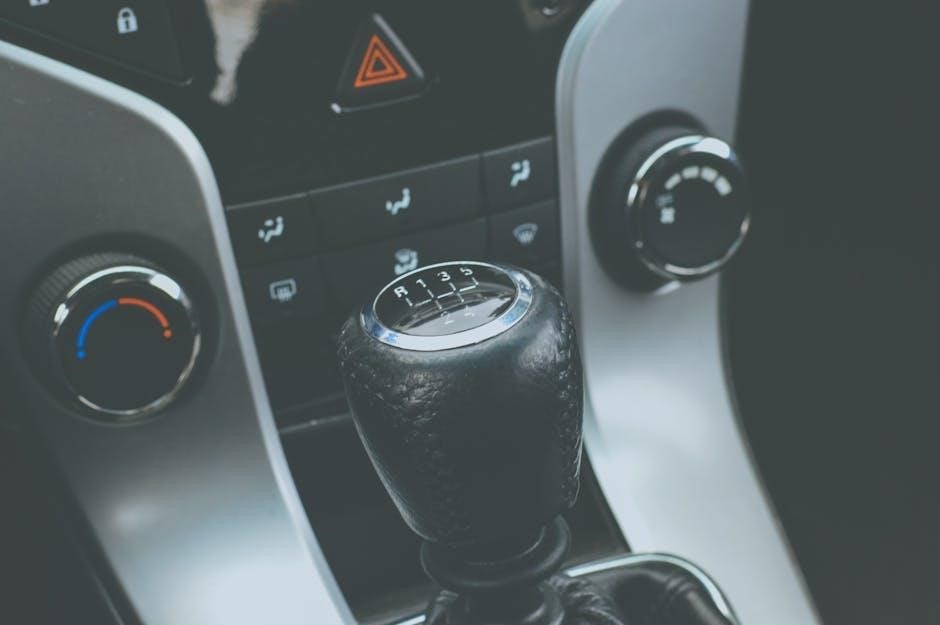Driving an Automatic Car with a Manual License: A Comprehensive Guide
Possessing a manual driving license typically grants you the privilege to operate both manual and automatic transmission vehicles․ This stems from the comprehensive skill set acquired during manual driving lessons, providing versatility on the road, according to general regulations worldwide․
Navigating the world of driving licenses can often feel like traversing a complex maze, especially when considering the nuances between manual and automatic vehicle operation․ License restrictions are in place to ensure that drivers possess the necessary skills and competence to handle the specific type of vehicle they are operating, thereby promoting road safety for all․
The core principle behind these restrictions lies in the differing skill sets required for driving manual versus automatic cars․ Manual vehicles demand proficiency in gear shifting, clutch control, and coordination – skills not essential for operating automatics․ Consequently, licensing authorities often distinguish between the two, reflecting the level of expertise demonstrated during the driving test․
This guide aims to demystify the rules surrounding driving an automatic car with a manual license, exploring the general principles, country-specific regulations, and potential consequences of non-compliance․ We will delve into the variations in license laws across different regions, highlighting the distinctions between the UK, Australia, the USA, and Europe․ Additionally, we will address the implications of driving outside your license restrictions, the process of upgrading an automatic license, and the benefits of holding a manual license․ By providing a comprehensive overview, this guide seeks to equip drivers with the knowledge necessary to navigate license regulations confidently and responsibly․
General Rule: Manual License Covers Automatic Vehicles
In most jurisdictions, a driver who has successfully obtained a manual driving license is typically permitted to operate vehicles with automatic transmissions․ This stems from the understanding that mastering a manual vehicle requires a broader range of skills compared to driving an automatic․ Successfully navigating the complexities of gear changes, clutch control, and coordinating these actions inherently equips the driver with the aptitude to handle the simpler mechanics of an automatic vehicle․
The rationale behind this general rule is that a manual license demonstrates a higher level of driving competence․ The skills learned while operating a manual vehicle, such as understanding engine RPM, clutch engagement, and gear selection, translate well to driving an automatic, where these elements are largely automated․ Therefore, licensing authorities generally recognize that individuals capable of driving a manual vehicle can also safely operate an automatic․
However, it is crucial to emphasize that this is a general rule and not a universal one․ Specific regulations can vary significantly between countries and even regions within countries․ Therefore, drivers should always consult the official driving regulations of their specific jurisdiction to confirm the precise rules regarding license endorsements and vehicle operation․
Country-Specific Regulations: Variations in License Laws
While the general principle often allows manual license holders to drive automatic vehicles, the landscape of driving regulations is far from uniform․ A critical aspect to understand is the significant variation in license laws across different countries and regions․ These variations can dictate whether a manual license automatically covers automatic vehicles or if specific endorsements or separate licenses are required․
Some countries maintain a strict distinction between manual and automatic licenses․ In these jurisdictions, passing a driving test in an automatic vehicle results in a license restricted solely to operating automatics․ Conversely, obtaining a manual license grants the privilege to drive both types of vehicles․ Other regions might employ a tiered system, where drivers can upgrade their automatic license to a manual one by completing additional training or testing․
These differences in regulations often reflect historical driving practices, infrastructure development, and cultural attitudes towards vehicle operation․ Factors such as the prevalence of manual transmissions, the availability of driver education programs, and the emphasis on specific driving skills can all influence how licensing authorities structure their rules․
Therefore, it is imperative for drivers to meticulously investigate the specific regulations of the country or region where they intend to drive․ Relying solely on general assumptions or experiences from other locations can lead to misunderstandings and potential legal repercussions․

The UK: A Clear Distinction
The United Kingdom exemplifies a nation with a notable distinction between manual and automatic driving licenses․ This clear separation dictates the types of vehicles a driver is permitted to operate based on the transmission type used during their driving test․ Passing the driving test in an automatic vehicle in the UK explicitly restricts the license holder to driving automatic vehicles only․ This means they are legally prohibited from operating a vehicle with a manual gearbox․
Conversely, individuals who successfully complete their driving test in a manual vehicle are granted the flexibility to drive both manual and automatic cars․ This stems from the UK’s recognition that mastering a manual transmission equips drivers with a broader understanding of vehicle control and mechanics․
This distinction in the UK reflects a long-standing emphasis on the skills required to operate a manual transmission vehicle, including clutch control, gear shifting, and coordination․ The rationale is that drivers proficient in manual transmissions can easily adapt to automatics, while those trained solely on automatics may lack the necessary skills and knowledge to safely operate a manual vehicle․
Therefore, drivers in the UK must carefully consider their long-term driving needs when deciding which type of vehicle to use for their driving test․ Choosing an automatic vehicle may provide a quicker path to obtaining a license, but it will limit their future driving options․
Australia: Upgrade Options in NSW
In New South Wales, Australia, the regulations surrounding driving licenses and vehicle transmission types offer a specific pathway for drivers holding an automatic license who wish to upgrade to a manual license․ If you initially obtain a license restricted to automatic vehicles and later desire the ability to drive manual transmission vehicles, NSW provides an avenue to achieve this;
The process involves adhering to learner driver rules while practicing in a manual vehicle․ Specifically, individuals with an automatic-only license must be accompanied by a fully licensed driver who holds a manual license․ This supervising driver must have held their full manual license for at least one year․ During this learning period, all standard learner driver regulations apply, ensuring safety and proper instruction․
To fully upgrade from an automatic to a manual license in NSW, you are required to undertake and pass a practical driving test in a manual vehicle․ This test assesses your ability to safely and competently operate a manual transmission vehicle, including gear changes, clutch control, and overall vehicle handling․ Successful completion of this test removes the automatic restriction from your license, granting you the authority to drive both automatic and manual vehicles․
This upgrade system in NSW provides flexibility for drivers who initially opt for an automatic license but later decide to expand their driving capabilities to include manual vehicles․
USA: State-Specific Rules and Possibilities
In the United States, driving license regulations are not uniform across the nation․ Instead, each state has its own distinct set of rules and requirements concerning driver’s licenses and vehicle operation․ This state-level autonomy extends to the matter of whether a driver licensed to operate an automatic transmission vehicle can also legally drive a manual transmission vehicle․
Generally, many states do not differentiate between automatic and manual licenses․ Passing a driving test in either type of vehicle typically grants the license holder the authority to operate both automatic and manual vehicles․ However, it is crucial to verify the specific regulations of the state in which the license is issued or where the driving will occur․
Some states might impose restrictions on licenses obtained through automatic vehicles, limiting the driver to operating only automatic vehicles․ In such cases, drivers wishing to operate manual vehicles would need to take an additional driving test in a manual vehicle to remove the restriction․
Therefore, it is imperative to consult the Department of Motor Vehicles (DMV) or equivalent agency in the relevant state to ascertain the precise rules regarding automatic and manual licenses․ These rules can vary significantly, and understanding the specific state’s regulations is essential to ensure legal and compliant driving practices․
Europe: Reciprocity and Restrictions
Within Europe, driving license regulations exhibit a degree of harmonization, but variations still exist concerning the operation of manual vehicles with an automatic license․ European Union (EU) directives aim to facilitate the mutual recognition of driving licenses across member states, promoting ease of movement for drivers within the union․
However, the specifics of license endorsements and restrictions can differ․ Generally, a license obtained through a manual transmission vehicle allows the holder to operate both manual and automatic vehicles throughout the EU․ This reflects the understanding that mastering a manual transmission encompasses the skills required for automatic vehicles․
Conversely, a license obtained solely through an automatic transmission vehicle might impose restrictions, limiting the driver to operating only automatic vehicles․ Some countries might require an additional practical test in a manual vehicle to remove this restriction and obtain a full license valid for both transmission types․ It is imperative to investigate the specific regulations of each country within Europe․
Furthermore, non-EU countries within Europe may have their own distinct rules regarding license reciprocity and restrictions․ Therefore, drivers planning to operate vehicles in Europe should verify the regulations of each specific country they intend to visit to ensure compliance with local laws․
What Happens If You Drive a Manual with an Automatic License?
Driving a manual transmission vehicle while holding only an automatic-only driving license constitutes a violation of driving regulations and carries potential consequences․ The severity of these consequences can vary depending on the jurisdiction and the specific circumstances of the infraction․ Generally, law enforcement views this as driving without a valid license for the specific vehicle type․
Upon being caught operating a manual vehicle with an automatic license, the driver may face several penalties․ These can include fines, which can range from moderate to substantial depending on local laws and prior driving history․ In addition to fines, the driver may accrue penalty points on their driving record; Accumulating a certain number of points within a specified period can lead to license suspension or revocation․
Furthermore, there’s a risk of vehicle impoundment․ Law enforcement might seize the vehicle being operated illegally, requiring the driver to undergo a process to reclaim it, often involving fees and proof of valid licensure․ In more severe cases, especially involving repeat offenses or aggravating factors like reckless driving, the driver could face criminal charges, potentially leading to a more extensive suspension or even imprisonment․
Penalties for Driving Outside License Restrictions
Operating a vehicle outside the restrictions stipulated on your driving license can lead to various penalties, the severity of which depends on the specific regulations of the jurisdiction․ Driving a manual car with an automatic-only license falls under this category and can result in significant repercussions․

One common penalty is a monetary fine․ The amount varies but can be substantial, especially for repeat offenders․ Additionally, points may be added to your driving record․ Accumulating too many points within a specific timeframe can lead to license suspension․
In some jurisdictions, driving outside license restrictions can lead to vehicle impoundment․ This means the vehicle is seized by authorities, and you’ll incur fees to retrieve it․ Furthermore, your insurance coverage may be voided if an accident occurs while driving illegally, leaving you financially responsible for damages and injuries․
In more serious cases, particularly involving repeat offenses, criminal charges may be filed, resulting in a criminal record and potential jail time․ The exact consequences depend on the specific laws and the discretion of law enforcement and the courts․
Upgrading an Automatic License to a Manual License
If you hold an automatic-only driving license and wish to operate manual transmission vehicles, upgrading your license is essential․ The process generally involves several steps to ensure you possess the necessary skills and knowledge to drive a manual car safely․
The first step often involves obtaining a learner’s permit or provisional license that permits you to drive a manual car under supervision․ This usually requires passing a written knowledge test covering traffic laws and safe driving practices․
Next, you’ll need to gain practical driving experience in a manual vehicle․ This can be achieved through professional driving lessons with a certified instructor or by practicing with a qualified supervisor who holds a full manual driving license․
Once you feel confident in your ability to operate a manual car safely, you’ll need to schedule and pass a practical driving test․ This test assesses your ability to control the vehicle, execute maneuvers, and adhere to traffic laws in a real-world driving environment․ Successful completion of the practical test will result in the issuance of a full manual driving license․
Taking a New Practical Driving Test
For those holding an automatic license aspiring to drive manual vehicles, a practical driving test is usually mandatory․ This evaluation determines driving competence․ The new practical driving test will assess your ability to safely operate a manual transmission vehicle․ You’ll need to demonstrate proficiency in clutch control, gear changes, and overall vehicle management․
Familiarize yourself with the testing criteria specific to your location, as requirements can vary․ Practice driving in diverse conditions, encompassing urban streets and highways, to master your skills․
During the test, maintaining composure and focus is crucial․ Listen attentively to the examiner’s instructions and execute maneuvers precisely․ Demonstrate consistent adherence to traffic laws and safe driving habits․ Smooth gear changes and effective use of mirrors are vital for evaluation․ Remember, the examiner is assessing your ability to drive safely and confidently in various situations․

Upon successfully passing the test, your license will be updated to allow you to drive manual transmission vehicles․
Supervising a Learner Driver with an Automatic License
The ability to supervise a learner driver with an automatic license hinges significantly on jurisdictional regulations․ Generally, if you hold an automatic license, you might not be permitted to supervise a learner driver operating a manual vehicle․ This restriction is due to the license holder’s lack of expertise in manual transmission operation․
However, if the learner driver is using an automatic vehicle, supervision is usually permissible, provided you meet other standard requirements․ These usually include holding a valid driver’s license for a specified duration, often at least one year․
It’s critical to verify the specific laws in your region, as penalties can arise from supervising without proper qualifications․ Always ensure the vehicle displays appropriate learner plates and adheres to all legal stipulations․ Even with an automatic license, your experience can be valuable, offering guidance on road safety, traffic awareness, and general driving etiquette․ Prioritize safety and regulatory compliance above all else․

Benefits of Obtaining a Manual License
Securing a manual driving license unlocks a broader spectrum of driving opportunities compared to an automatic-only license․ A primary advantage lies in the versatility it offers; with a manual license, you are legally permitted to operate both manual and automatic vehicles․ This flexibility becomes invaluable when renting cars, as you aren’t restricted to potentially more expensive automatic models․
Moreover, a manual license enhances your employment prospects, particularly in roles involving driving․ Many commercial vehicles and fleet cars still utilize manual transmissions․ Learning in a manual car also equips you with superior car control skills and a deeper understanding of vehicle mechanics, enabling you to react more effectively to diverse driving conditions․
Additionally, you gain the freedom to choose from a wider range of vehicle models when purchasing a car, as manual transmission cars tend to be more affordable․ Ultimately, a manual license offers greater independence and adaptability on the road, making it a worthwhile investment for any driver․